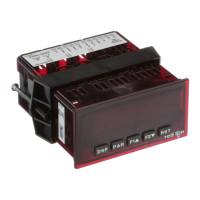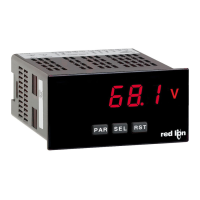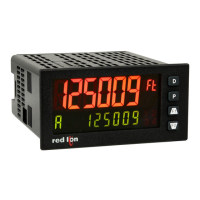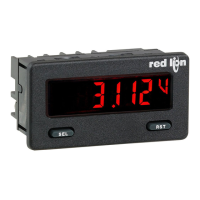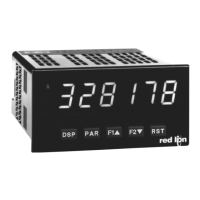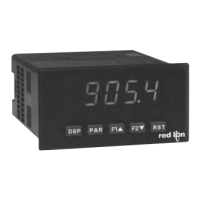DISPLAY PROCESS (INPUT)
%FS, 10-50 mA*
%FS, 0-1500 gpm*
0.00 0 0.00 10
6.32 94.8 0.20 10.08
10.43 156.45 1.00 10.40
18.04 270.60 3.10 11.24
27.58 413.70 7.40 12.96
39.09 586.35 15.00 16.00
52.61 789.15 27.30 20.92
68.18 1022.70 46.00 28.40
85.74 1286.10 72.90 39.16
100.00 1500.00 100.00 50.00
Examination of the data of the first example reveals a slope in the first linear
segment of 63.2 / (4.032-4.000) = 20 display units/uA, which exceeds the value at
which display stability is sacrificed (2 units/uA). Increasing the digital filtering to
level 1 stabilizes the display at low flow rates to acceptable levels, at the expense
of increased response time. Rounding the display to 0.2, 0.5 or 1.0 gpm further
increases stability at a sacrifice of display resolution. The linear slopes at higher
flow rates are well within the indicator’s capability and are very stable.
Following with the example of 0.1 gpm resolution, the values to be entered in
“Pro 2” to program this example are:
“dECPNt” “0.0” - Defines decimal point
“round” “0.1” - Defines rounding factor and dummy zeros
“SCALE” “yes” - Continue with scaling program
“dSP 1” “0.0” - Program first display point
“Inp 1” “4.00” - Program first input current point
“dSP 2” “63.2”
“Inp 2” “4.032”
“SEGt” “9” - Defines number of active linear segments
"SCALE” “yes” - Continue with scaling
“dSP 3” “104.3” - Program balance of scaling points
“INP 3” “4.16”
“dSP 4” “180.4”
“INP 4” “4.496”
“dSP 5” “275.8”
“INP 5” “5.184”
“dSP 6” “390.9”
“INP 6” “6.400”
“dSP 7” “526.1”
“INP 7” “8.368”
“dSP 8” “681.8”
“INP 8” “11.360”
“dSP 9” “857.4”
“INP 9” “15.664”
“dSP 10” “1000.0”
“INP 10” “20.000”
As a result of the scaling, the indicator is scaled to read directly in (gpm) from a
non-linear pressure transducer (4-20 mA), with 0.5% error.
PEAK/VALLEY
The other features of the totalizer/linearizer option are peak and valley
detection and a re-zero (tare) function. The indicator will record the lowest
reading (valley) and the highest reading (peak), automatically, for later recall.
This information is valuable in monitoring the limits of the process over any
length of time since these values are stored at power-down to span over shifts,
days, etc. An external input can be programmed to reset or engage the unit into a
peak/valley reading indicator. Additionally, the peak and valley can be viewed
and reset from the front panel, if so programmed, and viewed and reset from the
serial communication option.
Note: The peak/valley measurement is not instantaneous and is based on a
nominal 2 second response time.
TARE
The re-zero (tare) function can also be controlled externally, by the front panel
or through serial communications. This feature can quickly compensate for small
shifts or drifts in the input signal or to re-zero every operation, such as batching.
If the display error is greater than 1% of span due to transducer drift, it is
recommended to rescale the unit with “Pro 1” or “Pro 2”, rather than re-zero the
input. The tare buffer can be cleared by “stepping” through “Pro 2”, using the
“P” button or via serial communications.
-27-
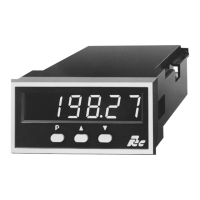
